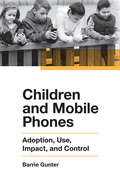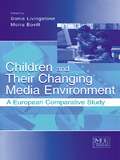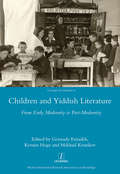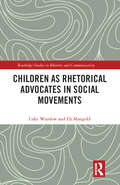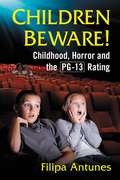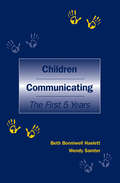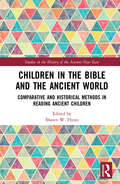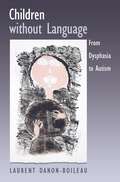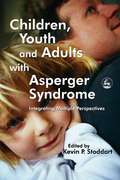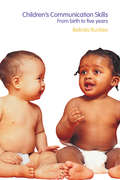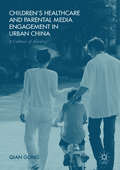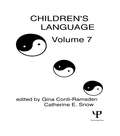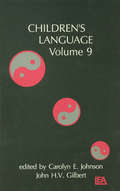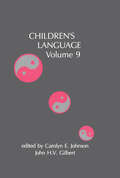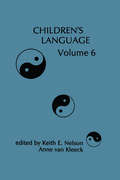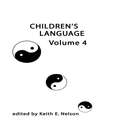- Table View
- List View
Children and Mobile Phones: Adoption, Use, Impact, and Control
by Barrie GunterThis book provides a resource for readers interested in the issues surrounding mobile phone use by children. Mobile phones are ubiquitous in young people’s lives around the world. Most teenagers and many pre-teenage children have their own mobile phone and carry it around everywhere they go. While the mobile phone remains an important communication device for making and receiving voice calls, technological advances have evolved the typical device far beyond simple functionality. Recent models are multi-functional mini-computers with ever-increasing power that enable users to communicate through a range of channels and to engage in multiple other activities. For many young people, life without their mobile phone is unimaginable, but mobile phones can be a source of risk and threat. Understanding how they are used and highlighting potential dangers is an essential activity to enable the creation of sensible and acceptable strategies to ensure that benefits are maximised and risks are minimised. Stakeholders such as parents, industry, regulators, government and children themselves all have vested interests in how children use mobile phones and bear some responsibility for young mobile users.
Children and Mobile Phones: Adoption, Use, Impact, and Control
by Barrie GunterThis book provides a resource for readers interested in the issues surrounding mobile phone use by children. Mobile phones are ubiquitous in young people’s lives around the world. Most teenagers and many pre-teenage children have their own mobile phone and carry it around everywhere they go. While the mobile phone remains an important communication device for making and receiving voice calls, technological advances have evolved the typical device far beyond simple functionality. Recent models are multi-functional mini-computers with ever-increasing power that enable users to communicate through a range of channels and to engage in multiple other activities. For many young people, life without their mobile phone is unimaginable, but mobile phones can be a source of risk and threat. Understanding how they are used and highlighting potential dangers is an essential activity to enable the creation of sensible and acceptable strategies to ensure that benefits are maximised and risks are minimised. Stakeholders such as parents, industry, regulators, government and children themselves all have vested interests in how children use mobile phones and bear some responsibility for young mobile users.
Children and Their Changing Media Environment: A European Comparative Study (Routledge Communication Series)
by Sonia Livingstone Moira BovillFocusing on the meanings, uses, and impacts of new media in childhood, family life, peer culture, and the relation between home and school, this volume sets out to address many of the questions, fears, and hopes regarding the changing place of media in the lives of today's children and young people. The scholars contributing to this work argue that such questions--intellectual, empirical, and policy-related--can be productively addressed through cross-national research. Hence, this volume brings together researchers from 12 countries--Belgium, Denmark, Finland, France, Germany, the United Kingdom, Israel, Italy, the Netherlands, Spain, Sweden, and Switzerland--to present original and comprehensive findings regarding the diffusion and significance of new media and information technologies among children. Inspired by parallels and difference between the arrival of television in the family home during the 1950s and the present day arrival of new media, the research is based on in-depth interviews and a detailed comparative survey of 6- to 16-year-olds across Europe and in Israel. The result is a comprehensive, detailed, and fascinating account of how these technologies are rapidly becoming central to the daily lives of young people. As a resource for researchers and students in media and communication studies, leisure and cultural studies, social psychology, and related areas, this volume provides crucial insights into the role of media in the lives of children. The findings included herein will also be of interest to policymakers in broadcasting, technology, and education throughout the world.
Children and Their Changing Media Environment: A European Comparative Study (Routledge Communication Series)
by Sonia Livingstone Moira BovillFocusing on the meanings, uses, and impacts of new media in childhood, family life, peer culture, and the relation between home and school, this volume sets out to address many of the questions, fears, and hopes regarding the changing place of media in the lives of today's children and young people. The scholars contributing to this work argue that such questions--intellectual, empirical, and policy-related--can be productively addressed through cross-national research. Hence, this volume brings together researchers from 12 countries--Belgium, Denmark, Finland, France, Germany, the United Kingdom, Israel, Italy, the Netherlands, Spain, Sweden, and Switzerland--to present original and comprehensive findings regarding the diffusion and significance of new media and information technologies among children. Inspired by parallels and difference between the arrival of television in the family home during the 1950s and the present day arrival of new media, the research is based on in-depth interviews and a detailed comparative survey of 6- to 16-year-olds across Europe and in Israel. The result is a comprehensive, detailed, and fascinating account of how these technologies are rapidly becoming central to the daily lives of young people. As a resource for researchers and students in media and communication studies, leisure and cultural studies, social psychology, and related areas, this volume provides crucial insights into the role of media in the lives of children. The findings included herein will also be of interest to policymakers in broadcasting, technology, and education throughout the world.
Children and Yiddish Literature From Early Modernity to Post-Modernity
by Gennady Estraikh Kerstin Hoge Krutikov MikhailChildren have occupied a prominent place in Yiddish literature since early modern times, but children’s literature as a genre has its beginnings in the early 20th century. Its emergence reflected the desire of Jewish intellectuals to introduce modern forms of education, and promote ideological agendas, both in Eastern Europe and in immigrant communities elsewhere. Before the Second World War, a number of publishing houses and periodicals in Europe and the Americas specialized in stories, novels and poems for various age groups. Prominent authors such as Yankev Glatshteyn, Der Nister, Joseph Opatoshu, Leyb Kvitko, made original contributions to the genre, while artists, such as Marc Chagall, El Lissitzky and Yisakhar Ber Rybak, also took an active part. In the Soviet Union, meanwhile, children’s literature provided an opportunity to escape strong ideological pressure. Yiddish children’s literature is still being produced today, both for secular and strongly Orthodox communities. This volume is a pioneering collective study not only of children’s literature but of the role played by children in literature.
Children and Yiddish Literature From Early Modernity to Post-Modernity: From Early Modernity To Post-modernity (Legenda Ser.)
by Gennady Estraikh Kerstin Hoge Krutikov MikhailChildren have occupied a prominent place in Yiddish literature since early modern times, but children’s literature as a genre has its beginnings in the early 20th century. Its emergence reflected the desire of Jewish intellectuals to introduce modern forms of education, and promote ideological agendas, both in Eastern Europe and in immigrant communities elsewhere. Before the Second World War, a number of publishing houses and periodicals in Europe and the Americas specialized in stories, novels and poems for various age groups. Prominent authors such as Yankev Glatshteyn, Der Nister, Joseph Opatoshu, Leyb Kvitko, made original contributions to the genre, while artists, such as Marc Chagall, El Lissitzky and Yisakhar Ber Rybak, also took an active part. In the Soviet Union, meanwhile, children’s literature provided an opportunity to escape strong ideological pressure. Yiddish children’s literature is still being produced today, both for secular and strongly Orthodox communities. This volume is a pioneering collective study not only of children’s literature but of the role played by children in literature.
Children as Rhetorical Advocates in Social Movements (Routledge Studies in Rhetoric and Communication)
by Luke Winslow Eli MangoldThis book examines “Rhetorical Children” as visible and vocal communicators, shaping public discourse on contentious social issues related to organized labor, civil rights, gun violence, and climate change. This book explores four key social movement case studies: the 1903 Mother Jones-led March of the Mill Children to reform child labor laws, the 1963 Dr. Martin Luther King, Jr.,-led Children’s Crusade to end segregation, the 2018 Parkland student-led March for Our Lives movement to end gun violence, and the ongoing struggle for climate change mitigation led by Swedish activist Greta Thunberg. Through these case studies, the book outlines three rhetorical strategies, namely children’s ability to activate adults’ moral obligation; to invoke threats to natality and lost childhood; and to disrupt social order. It enables readers to better understand rhetorical children and the rhetorical tools required for social movements. Assessing the powerful role children play in shaping public discourse, this book will be of interest to students and scholars in the fields of Communication Studies, Rhetoric, Public Address, Social Movements, and Cultural Studies.
Children as Rhetorical Advocates in Social Movements (Routledge Studies in Rhetoric and Communication)
by Luke Winslow Eli MangoldThis book examines “Rhetorical Children” as visible and vocal communicators, shaping public discourse on contentious social issues related to organized labor, civil rights, gun violence, and climate change. This book explores four key social movement case studies: the 1903 Mother Jones-led March of the Mill Children to reform child labor laws, the 1963 Dr. Martin Luther King, Jr.,-led Children’s Crusade to end segregation, the 2018 Parkland student-led March for Our Lives movement to end gun violence, and the ongoing struggle for climate change mitigation led by Swedish activist Greta Thunberg. Through these case studies, the book outlines three rhetorical strategies, namely children’s ability to activate adults’ moral obligation; to invoke threats to natality and lost childhood; and to disrupt social order. It enables readers to better understand rhetorical children and the rhetorical tools required for social movements. Assessing the powerful role children play in shaping public discourse, this book will be of interest to students and scholars in the fields of Communication Studies, Rhetoric, Public Address, Social Movements, and Cultural Studies.
Children Beware!: Childhood, Horror and the PG-13 Rating (PDF)
by Filipa AntunesHow does a culture respond when the limits of childhood become uncertain? The emergence of pre-adolescence in the 1980s, signified in part by the new PG-13 rating for film, disrupted the established boundaries between childhood and adulthood and affected not only America's pillar ideals of family and childhood innocence but also the very foundation of the horror genre's identity: an association with maturity and exclusivity. Cultural disputes over the limits of childhood and horror were explicitly articulated in the children's horror trend (1980-1997), a cluster of child-oriented horror titles in film and other media, which included Gremlins, The Gate, the Goosebumps series, and others. As the first serious analysis of the children's horror trend, with a focus on the effects of ratings, this book provides a complete chart of its development while presenting it as a document of American culture's adaptation to pre-adolescence, with each important children's horror title corresponding to a key moment of ideological negotiation, cultural power struggles, and industrial compromise. This book includes an appendix of children's horror from the Scooby-Doo franchise in 1969 to Netflix's Stranger Things in 2016 and many of the films, novels, and television series in between.
Children Communicating: The First 5 Years
by Wendy Samter Beth Bonniwell HaslettOffering a unique focus on the development of human communication, this book integrates and synthesizes a more comprehensive array of research than most investigations of communicative development. As such, it incorporates materials dealing with the development of nonverbal communication, language, and cognition, and examines how they are integrated in the growing child's everyday interaction. This information is distilled into a set of key principles and practices--culled from a variety of fields including developmental and social psychology, sociolinguistics, psycholinguistics, and communication--for parents or adults interested in child development. While this book does not offer an in-depth view in any one area, it provides a comprehensive overview of the various components of human communicative development and its significance for the child's cognitive and emotional growth. It is quite clear that developmental processes are constrained by multiple influences whose interactions have just begun to be uncovered. Examining the diverse facets of communicative development will enable professionals to garner further insights into the mystery of human communication.
Children Communicating: The First 5 Years (Routledge Communication Ser.)
by Wendy Samter Beth Bonniwell HaslettOffering a unique focus on the development of human communication, this book integrates and synthesizes a more comprehensive array of research than most investigations of communicative development. As such, it incorporates materials dealing with the development of nonverbal communication, language, and cognition, and examines how they are integrated in the growing child's everyday interaction. This information is distilled into a set of key principles and practices--culled from a variety of fields including developmental and social psychology, sociolinguistics, psycholinguistics, and communication--for parents or adults interested in child development. While this book does not offer an in-depth view in any one area, it provides a comprehensive overview of the various components of human communicative development and its significance for the child's cognitive and emotional growth. It is quite clear that developmental processes are constrained by multiple influences whose interactions have just begun to be uncovered. Examining the diverse facets of communicative development will enable professionals to garner further insights into the mystery of human communication.
Children in the Bible and the Ancient World: Comparative and Historical Methods in Reading Ancient Children (Studies in the History of the Ancient Near East)
by Shawn W. FlynnThe topic of children in the Bible has long been under-represented, but this has recently changed with the development of childhood studies in broader fields, and the work of several dedicated scholars. While many reading methods are employed in this emerging field, comparative work with children in the ancient world has been an important tool to understand the function of children in biblical texts. Children in the Bible and the Ancient World broadly introduces children in the ancient world, and specifically children in the Bible. It brings together an international group of experts who help readers understand how children are constructed in biblical literature across three broad areas: children in the Hebrew Bible and the Ancient Near East, children in Christian writings and the Greco-Roman world, and children and materiality. The diverse essays cover topics such as: vows in Ugarit and the Hebrew Bible, obstetric knowledge, infant abandonment, the role of marriage, Greek abandonment texts, ritual entry for children into Christian communities, education, sexual abuse, and the role of archeological figurines in children’s lives. The volume also includes expertise in biological anthropology to study the skeletal remains of ancient children, as well as how ancient texts illuminate Mary’s female maturity. The volume is written in an accessible style suitable for non-specialists, and it is equipped with a helpful resource bibliography that organizes select secondary sources from these essays into meaningful categories for further study. Children in the Bible and the Ancient World is a helpful introduction to any who study children and childhood in the ancient world. In addition, the volume will be of interest to experts who are engaged in historical approaches to biblical studies, while appreciating how the ancient world continues to illuminate select topics in biblical texts.
Children in the Bible and the Ancient World: Comparative and Historical Methods in Reading Ancient Children (Studies in the History of the Ancient Near East)
by Shawn W. FlynnThe topic of children in the Bible has long been under-represented, but this has recently changed with the development of childhood studies in broader fields, and the work of several dedicated scholars. While many reading methods are employed in this emerging field, comparative work with children in the ancient world has been an important tool to understand the function of children in biblical texts. Children in the Bible and the Ancient World broadly introduces children in the ancient world, and specifically children in the Bible. It brings together an international group of experts who help readers understand how children are constructed in biblical literature across three broad areas: children in the Hebrew Bible and the Ancient Near East, children in Christian writings and the Greco-Roman world, and children and materiality. The diverse essays cover topics such as: vows in Ugarit and the Hebrew Bible, obstetric knowledge, infant abandonment, the role of marriage, Greek abandonment texts, ritual entry for children into Christian communities, education, sexual abuse, and the role of archeological figurines in children’s lives. The volume also includes expertise in biological anthropology to study the skeletal remains of ancient children, as well as how ancient texts illuminate Mary’s female maturity. The volume is written in an accessible style suitable for non-specialists, and it is equipped with a helpful resource bibliography that organizes select secondary sources from these essays into meaningful categories for further study. Children in the Bible and the Ancient World is a helpful introduction to any who study children and childhood in the ancient world. In addition, the volume will be of interest to experts who are engaged in historical approaches to biblical studies, while appreciating how the ancient world continues to illuminate select topics in biblical texts.
Children without Language: From Dysphasia to Autism
by Laurent Danon-BoileauCommunication and language disorders are often considered from one particular point of view - either psychological or neurological. Danon-Boileau argues that this is a serious mistake. He emphasizes that a child's trouble can stem from a variety of causes: neurological problems similar to those of aphasia, cognitive impairments, and psychological disorders, and, thus, the interaction of these elements needs to be taken into account. In precise case studies, Danon-Boileau describes the situations he has confronted and traces the causes of changes in the child when they happen. Combining linguistic, cognitive, and psycholanalytic approaches, Children without Language provides a unique perspective on speech and communication disorders in children and will be an essential volume for speech therapists, developmental psychologists, linguistics scholars and anyone wishing to reflect seriously on why we speak and how communication occurs.
Children, Youth and Adults with Asperger Syndrome: Integrating Multiple Perspectives
by Kevin StoddartThis book offers a comprehensive overview of clinical, research and personal perspectives on Asperger Syndrome, including contributions from parents and experts in the fields of psychology, social work, psychiatry, genetics, sexology and vocational counselling. It includes first-hand accounts from adults with AS, highlighting their difficulties in areas such as social competence and education. Specialist perspectives on AS, including sexuality and relationships, finding and keeping employment and anxiety and depression are sensitively addressed. The viewpoints of parents explore experiences of parenting AS individuals. These varied approaches to living with AS complement the emerging literature on theory, research and practice in this area. The broad scope of Children, Youth and Adults with Asperger Syndrome guarantees a wide readership among practitioners, students, parents, young people and adults with AS, educates service providers how to assist people with AS and suggests a model of interdisciplinary collaboration for administrators and funders.
Children, Youth and Adults with Asperger Syndrome: Integrating Multiple Perspectives (PDF)
by Kevin StoddartThis book offers a comprehensive overview of clinical, research and personal perspectives on Asperger Syndrome, including contributions from parents and experts in the fields of psychology, social work, psychiatry, genetics, sexology and vocational counselling. It includes first-hand accounts from adults with AS, highlighting their difficulties in areas such as social competence and education. Specialist perspectives on AS, including sexuality and relationships, finding and keeping employment and anxiety and depression are sensitively addressed. The viewpoints of parents explore experiences of parenting AS individuals. These varied approaches to living with AS complement the emerging literature on theory, research and practice in this area. The broad scope of Children, Youth and Adults with Asperger Syndrome guarantees a wide readership among practitioners, students, parents, young people and adults with AS, educates service providers how to assist people with AS and suggests a model of interdisciplinary collaboration for administrators and funders.
Children's Communication Skills: From Birth to Five Years
by Belinda BuckleyBased on a huge body of research in child language and communication development, Children's Communication Skills uses a clear format to set out the key stages of communication development in babies and young children. Its aim is to increase awareness in professionals working with children of what constitutes human communication and what communication skills to expect at any given stage. Illustrated throughout with real-life examples, this informative text addresses: normal development of verbal and non-verbal communication skills the importance of play in developing these skills developmental communication problems bilingualism, cognition and early literacy development working with parents of children with communication difficulties. Features designed to make the book an easy source of reference include chapter summaries, age-specific skills tables, sections on warning signs that further help may be needed, and a glossary of key terms. It will be of great use to a wide range of professionals in training or working in health, education and social care.
Children's Communication Skills: From Birth to Five Years
by Belinda BuckleyBased on a huge body of research in child language and communication development, Children's Communication Skills uses a clear format to set out the key stages of communication development in babies and young children. Its aim is to increase awareness in professionals working with children of what constitutes human communication and what communication skills to expect at any given stage. Illustrated throughout with real-life examples, this informative text addresses: normal development of verbal and non-verbal communication skills the importance of play in developing these skills developmental communication problems bilingualism, cognition and early literacy development working with parents of children with communication difficulties. Features designed to make the book an easy source of reference include chapter summaries, age-specific skills tables, sections on warning signs that further help may be needed, and a glossary of key terms. It will be of great use to a wide range of professionals in training or working in health, education and social care.
Children’s Healthcare and Parental Media Engagement in Urban China: A Culture of Anxiety?
by Qian GongThis book analyses parental anxieties about their children’s healthcare issues in urban China, engaging with wider theoretical debates about modernity, risk and anxiety. It examines the broader social, cultural and historical contexts of parental anxiety by analysing a series of socio-economic changes and population policy changes in post-reform China that contextualise parental experiences. Drawing on Wilkinson’s (2001) conceptualisation linking individual’s risk consciousness to anxiety, this book analyses the situated risk experiences of parents’ and grandparents’, looking particularly into their engagement with various types of media. It studies the representations of health issues and health-related risks in a parenting magazine, popular newspapers, commercial advertising and new media, as well as parents’ and grandparents’ engagement with and response to these media representations. By investigating ‘a culture of anxiety’ among parents and grandparents in contemporary China, this book seeks to add to the scholarship of contemporary parenthood in a non- Western context.
Children's Language: Volume 7 (Children's Language Series)
by Gina Conti-Ramsden Catherine E. SnowThis volume presents current research findings on vital issues in language development compiled by an international group of leading researchers. The data are drawn from studies of the acquisition of Swedish, Polish, Serbo-Croatian, Hungarian, Portuguese, Italian, and English. Themes emphasized in all the chapters include the importance of the social context of acquisition, the existence of interconnections among various domains of language development, and the impossibility of understanding acquisition using a simple theory or a single methodological approach.
Children's Language: Volume 7 (Children's Language Series)
by Gina Conti-Ramsden Catherine E. SnowThis volume presents current research findings on vital issues in language development compiled by an international group of leading researchers. The data are drawn from studies of the acquisition of Swedish, Polish, Serbo-Croatian, Hungarian, Portuguese, Italian, and English. Themes emphasized in all the chapters include the importance of the social context of acquisition, the existence of interconnections among various domains of language development, and the impossibility of understanding acquisition using a simple theory or a single methodological approach.
Children's Language: Volume 9 (Children's Language Series)
by John H. V. Gilbert Carolyn E. JohnsonThis volume brings together the work of 32 scholars from 13 countries -- investigations of children learning 15 different languages, in some instances more than one at a time. The scope of this work -- as broad as it is -- only partially represents the research interests and approaches of the more than 350 scholars from 34 countries who contributed papers or posters to the Sixth International Congress for the Study of Child Language. This investigative power and diversity are, for the most part, focused on topics and issues of modern day child language research that have been under discussion for the last 30 years or so. Some even go beyond that in early diary studies and philosophers' speculations. While the issues are mainly familiar ones, the 17 chapters contribute to the advancement of child language study in several specific ways. They: * represent current theoretical frameworks, both bringing the insights of the theories to the interpretation of language development and testing tenets or implications of the theories with child language data; * contribute substantively to the crosslinguistic study of child language, reflecting both the linguistic diversity of the authors themselves and a recent major shift in the approach to child language study; * build on the now considerable body of knowledge about children's language, both adding to information about the basic systems of phonology, syntax, and semantics, and extending beyond to explore aspects of narrative and literacy development, language acquisition by bilingual and atypical children, and language processing; and * contain hints of new directions in child language study, such as increased attention to the impact of phonology on other language systems. Taken as a whole, this volume reflects the current strength of crosslinguistic research, the application and testing of new theoretical developments, a new legitimacy of language disorder data, and a new appeal to the descriptive possibilities of language processing models. In addition, there is a theme that runs through many of the chapters and points the way for important research in the future: the role of prosody in the acquisition of various language structures and systems.
Children's Language: Volume 9 (Children's Language Series)
by Carolyn E. Johnson John H. V. GilbertThis volume brings together the work of 32 scholars from 13 countries -- investigations of children learning 15 different languages, in some instances more than one at a time. The scope of this work -- as broad as it is -- only partially represents the research interests and approaches of the more than 350 scholars from 34 countries who contributed papers or posters to the Sixth International Congress for the Study of Child Language. This investigative power and diversity are, for the most part, focused on topics and issues of modern day child language research that have been under discussion for the last 30 years or so. Some even go beyond that in early diary studies and philosophers' speculations. While the issues are mainly familiar ones, the 17 chapters contribute to the advancement of child language study in several specific ways. They: * represent current theoretical frameworks, both bringing the insights of the theories to the interpretation of language development and testing tenets or implications of the theories with child language data; * contribute substantively to the crosslinguistic study of child language, reflecting both the linguistic diversity of the authors themselves and a recent major shift in the approach to child language study; * build on the now considerable body of knowledge about children's language, both adding to information about the basic systems of phonology, syntax, and semantics, and extending beyond to explore aspects of narrative and literacy development, language acquisition by bilingual and atypical children, and language processing; and * contain hints of new directions in child language study, such as increased attention to the impact of phonology on other language systems. Taken as a whole, this volume reflects the current strength of crosslinguistic research, the application and testing of new theoretical developments, a new legitimacy of language disorder data, and a new appeal to the descriptive possibilities of language processing models. In addition, there is a theme that runs through many of the chapters and points the way for important research in the future: the role of prosody in the acquisition of various language structures and systems.
Children's Language: Volume 6 (Children's Language Series)
by Keith E. Nelson; Anne van KleeckThis series, Children’s Language, reflects the conviction that extensive work on entirely new fronts along with a great deal of reinterpretation of old-front data will be necessary before any persuasive and truly orderly account of language development can be assembled. None of the chapters are simply reviews, and none of the volumes are " handbooks" or " reviews" or introductory texts. Rather the volumes try to capture the excitement and complexity of thinking and research at the growing, advancing edges of this broad field of children’s language. In line with these goals for the Children’s Language series the present volume includes coverage of a fairly wide range of topics and subtopics. The authors for each chapter will weave their own story and we leave to them the introduction of their main plots and the major and minor characters in their scientific stories. This is volume 6.
Children's Language: Volume 4 (Children's Language Series)
by K. E. NelsonFirst published in 1983. Routledge is an imprint of Taylor & Francis, an informa company.
